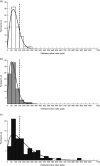Can desalinated seawater contribute to iodine-deficiency disorders? An observation and hypothesis
- PMID: 27149907
- PMCID: PMC10271113
- DOI: 10.1017/S1368980016000951
Can desalinated seawater contribute to iodine-deficiency disorders? An observation and hypothesis
Abstract
Objective: Over 300 million people rely on desalinated seawater and the numbers are growing. Desalination removes iodine from water and could increase the risk of iodine-deficiency disorders (IDD). The present study assessed the relationship between iodine intake and thyroid function in an area reliant on desalination.
Design: A case-control study was performed between March 2012 and March 2014. Thyroid function was rigorously assessed by clinical examination, ultrasound and blood tests, including serum thyroglobulin (Tg) and autoimmune antibodies. Iodine intake and the contribution made by unfiltered tap water were estimated by FFQ. The contribution of drinking-water to iodine intake was modelled using three iodine concentrations: likely, worst-case and best-case scenario.
Setting: The setting for the study was a hospital located on the southern Israeli Mediterranean coast.
Subjects: Adult volunteers (n 102), 21-80 years old, prospectively recruited.
Results: After screening, seventy-four participants met the inclusion criteria. Thirty-seven were euthyroid controls. Among those with thyroid dysfunction, twenty-nine were classified with non-autoimmune thyroid disease (NATD) after excluding eight cases with autoimmunity. Seventy per cent of all participants had iodine intake below the Estimated Average Requirement (EAR) of 95 µg/d. Participants with NATD were significantly more likely to have probable IDD with intake below the EAR (OR=5·2; 95 % CI 1·8, 15·2) and abnormal serum Tg>40 ng/ml (OR=5·8; 95 % CI 1·6, 20·8).
Conclusions: Evidence of prevalent probable IDD in a population reliant on desalinated seawater supports the urgent need to probe the impact of desalinated water on thyroid health in Israel and elsewhere.
Keywords: Iodine-deficiency disorders; Seawater reverse-osmosis desalination; Semi-quantitative iodine FFQ; Thyroglobulin.
Figures

Similar articles
-
Low intake of iodized salt and iodine containing supplements among pregnant women with apparently insufficient iodine status - time to change policy?Isr J Health Policy Res. 2020 Mar 30;9(1):9. doi: 10.1186/s13584-020-00367-4. Isr J Health Policy Res. 2020. PMID: 32223752 Free PMC article.
-
[SERUM THYROGLOBULIN LEVELS AND ESTIMATED IODINE INTAKE IN ADULTS EXPOSED TO IODINE‑DILUTED DESALINATED DRINKING WATER].Harefuah. 2016 Aug;155(8):470-474. Harefuah. 2016. PMID: 28530326 Hebrew.
-
Iodine deficiency influences thyroid autoimmunity in old age--a comparative population-based study.Maturitas. 2012 Jan;71(1):39-43. doi: 10.1016/j.maturitas.2011.10.001. Epub 2011 Nov 9. Maturitas. 2012. PMID: 22078658
-
Iodine requirements and the risks and benefits of correcting iodine deficiency in populations.J Trace Elem Med Biol. 2008;22(2):81-92. doi: 10.1016/j.jtemb.2008.03.001. Epub 2008 May 7. J Trace Elem Med Biol. 2008. PMID: 18565420 Review.
-
Iodine intake and the pattern of thyroid disorders: a comparative epidemiological study of thyroid abnormalities in the elderly in Iceland and in Jutland, Denmark.J Clin Endocrinol Metab. 1998 Mar;83(3):765-9. doi: 10.1210/jcem.83.3.4624. J Clin Endocrinol Metab. 1998. PMID: 9506723 Review.
Cited by
-
Iodine deficiency in Israeli pregnant women - a time for action.Isr J Health Policy Res. 2020 May 1;9(1):20. doi: 10.1186/s13584-020-00382-5. Isr J Health Policy Res. 2020. PMID: 32357947 Free PMC article.
-
Maternal iodine deficiency: a newborns' overweight risk factor? A prospective study.Arch Gynecol Obstet. 2022 Mar;305(3):777-787. doi: 10.1007/s00404-021-06261-x. Epub 2021 Oct 2. Arch Gynecol Obstet. 2022. PMID: 34599677
-
Can Mild-to-Moderate Iodine Deficiency during Pregnancy Alter Thyroid Function? Lessons from a Mother-Newborn Cohort.Nutrients. 2022 Dec 15;14(24):5336. doi: 10.3390/nu14245336. Nutrients. 2022. PMID: 36558495 Free PMC article.
-
Impact of iodine intake on the pathogenesis of autoimmune thyroid disease in children and adults.Ann Pediatr Endocrinol Metab. 2022 Dec;27(4):256-264. doi: 10.6065/apem.2244186.093. Epub 2022 Dec 31. Ann Pediatr Endocrinol Metab. 2022. PMID: 36567462 Free PMC article.
-
Low intake of iodized salt and iodine containing supplements among pregnant women with apparently insufficient iodine status - time to change policy?Isr J Health Policy Res. 2020 Mar 30;9(1):9. doi: 10.1186/s13584-020-00367-4. Isr J Health Policy Res. 2020. PMID: 32223752 Free PMC article.
References
-
- Zimmermann MB, Jooste PL & Pandav CS (2008) Iodine-deficiency disorders. Lancet 372, 1251–1262. - PubMed
-
- Michalaki M, Kyriazopoulou V, Paraskevopoulou P et al.. (2008) The odyssey of nontoxic nodular goiter (NTNG) in Greece under suppression therapy, and after improvement of iodine deficiency. Thyroid 18, 641–645. - PubMed
-
- Aghini Lombardi E, Fiore M, Tonacchera L et al.. (2013) The effect of voluntary iodine prophylaxis in a small rural community: the Pescopagano survey 15 years later. J Clin Endocrinol Metab 98, 1031–1039. - PubMed
-
- World Health Organization, UNICEF & International Council for Control of Iodine Deficiency Disorders (2007) Assessment of Iodine Deficiency Disorders and Monitoring Their Elimination: A Guide for Programme Managers, 3rd ed. Geneva: WHO.
-
- Zimmermann MB & Boelaert K (2015) Iodine deficiency and thyroid disorders. Lancet Diabetes Endocrinol 3, 286–295. - PubMed
MeSH terms
Substances
LinkOut - more resources
Full Text Sources
Other Literature Sources
Medical
Miscellaneous

